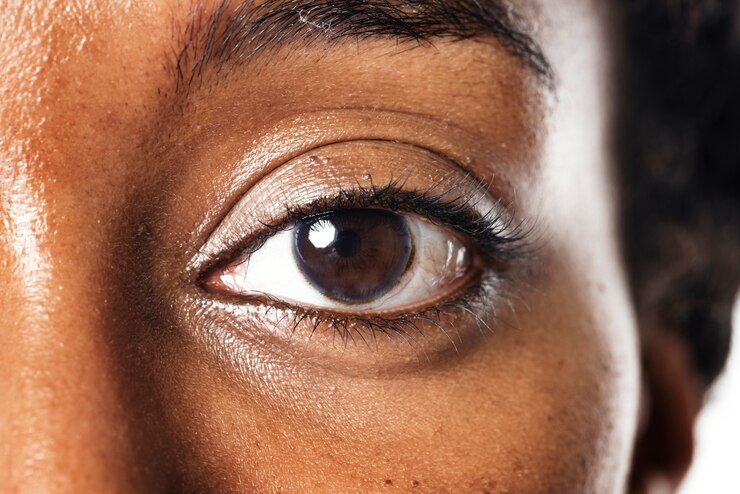Is Thyroid Damaging Your Eyes?
June 20, 2024
Have Any Questions?
Please contact us, if you have any queries
Categories

THYROID AND EYE HEALTH
The thyroid gland, a butterfly-shaped organ located in the neck, plays a crucial role in regulating metabolism and overall bodily functions. The thyroid gland produces hormones that regulate metabolism, energy levels, and various physiological processes. However, its influence extends beyond metabolic processes, significantly impacting eye health. When the thyroid gland malfunctions, it can lead to disorders such as hyperthyroidism (overactive thyroid) or hypothyroidism (underactive thyroid). One particular condition, Graves’ disease, an autoimmune disorder causing hyperthyroidism, is closely associated with eye problems, known as Thyroid Eye Disease (TED) or Graves’ orbitopathy.
THYROID EYE DISEASE (TED):
TED is an inflammatory condition affecting the muscles and tissues around the eyes. It is most commonly seen in individuals with Graves’ disease, although it can occasionally occur in those with hypothyroidism or even in people with normal thyroid function. TED can cause a range of symptoms from mild irritation to severe vision impairment, significantly impacting a person’s quality of life.
HOW THYROID IMPACTS OUR VISION
Thyroid dysfunction can lead to several eye-related issues, primarily due to inflammation and abnormal immune responses. Here are the key ways thyroid problems can affect vision:
- Proptosis (Exophthalmos): One of the hallmark symptoms of TED is proptosis, where the eyes bulge forward. This occurs due to swelling and inflammation of the eye muscles and fatty tissues behind the eye. Proptosis can lead to a staring appearance and cause discomfort or pain.
- Dry Eyes: Thyroid dysfunction can reduce tear production, leading to dry eyes. Insufficient lubrication can cause irritation, redness, a gritty sensation, and even damage to the cornea over time.
- Double Vision (Diplopia): Swollen eye muscles can become stiff and misaligned, causing double vision. This can make daily activities like reading, driving, or even walking difficult and uncomfortable.
- Vision Loss: In severe cases, TED can compress the optic nerve, leading to optic neuropathy. This compression can result in vision loss, which may be irreversible if not treated promptly.
- Lid Retraction and Lag: The upper eyelid may retract (pull back) or lag behind when looking down, causing the eyes to appear more open than usual. This can contribute to dry eyes and increased sensitivity to light.
SYMPTOMS TO IDENTIFY WHETHER THE THYROID IS DAMAGING YOUR EYES
Recognizing the symptoms of thyroid-related eye problems early is crucial for seeking appropriate treatment and preventing further damage. Here are common signs to watch for:
- Bulging Eyes: A noticeable bulging or protrusion of one or both eyes is a clear indicator of TED. This symptom can develop gradually and may be accompanied by discomfort or pain.
- Eye Redness and Irritation: Chronic redness, swelling, or a feeling of grittiness in the eyes can suggest thyroid-related inflammation. This is often due to dry eyes or irritation from swollen tissues.
- Excessive Tearing or Dryness: Paradoxically, thyroid eye disease can cause both excessive tearing and dry eyes. This imbalance occurs because of the disruption in normal tear production and drainage.
- Double Vision: Persistent double vision or difficulty focusing on objects can be a sign of misaligned eye muscles. This symptom can vary in severity and may worsen over time.
- Light Sensitivity: Increased sensitivity to light (photophobia) can occur due to eyelid retraction or corneal exposure from dry eyes. Bright lights may cause discomfort or pain.
- Difficulty Moving Eyes: Stiffness or pain when moving the eyes, particularly when looking up or sideways, can indicate inflamed or swollen eye muscles.
- Vision Changes: Blurred vision, reduced color perception, or sudden loss of vision are serious symptoms that require immediate medical attention. These changes could indicate optic nerve involvement.
MANAGING THYROID-RELATED EYE PROBLEMS
Effective management of thyroid-related eye problems involves a combination of treating the underlying thyroid disorder and addressing the eye symptoms directly. Here are key strategies for managing these issues:
- Thyroid Treatment: Regulating thyroid hormone levels is the first step in managing TED. This may involve medications to control hyperthyroidism, radioactive iodine therapy, or thyroid surgery. Proper thyroid management can help reduce the severity of eye symptoms.
- Eye Lubrication: Using artificial tears or lubricating eye drops can help alleviate dryness and irritation. Gel or ointment formulations may be recommended for more severe cases, particularly at night.
- Steroid Therapy: Inflammatory symptoms may be treated with corticosteroids to reduce swelling and pain. These can be administered orally or intravenously, depending on the severity of the symptoms.
- Radiation Therapy: In some cases, low-dose radiation therapy may be used to reduce inflammation and swelling around the eyes. This treatment is typically considered when steroid therapy is insufficient.
- Surgical Intervention: Severe cases of TED may require surgical intervention to correct proptosis, relieve optic nerve compression, or improve eyelid function. Orbital decompression surgery, strabismus surgery (to correct double vision), and eyelid surgery are potential options.
- Lifestyle Modifications: Simple changes such as wearing sunglasses to reduce light sensitivity, using a humidifier to maintain moisture in the air, and applying cool compresses to reduce swelling can provide symptomatic relief.
Thyroid dysfunction can significantly impact eye health, particularly in conditions like Graves’ disease and thyroid eye disease. Understanding the connection between thyroid problems and vision is essential for early detection and effective management. Recognizing symptoms such as bulging eyes, double vision, and dry eyes can help identify thyroid-related eye issues. Comprehensive treatment, including thyroid regulation, eye lubrication, and potentially surgical interventions, is crucial for preserving vision and improving quality of life. If you experience any symptoms of thyroid-related eye problems, seek medical advice promptly to ensure timely and effective care.
For any eye related problems, schedule an appointment with Dr. Rani Menon Maxivision Eye Hospitals. We help you with latest technology and expert doctors.



